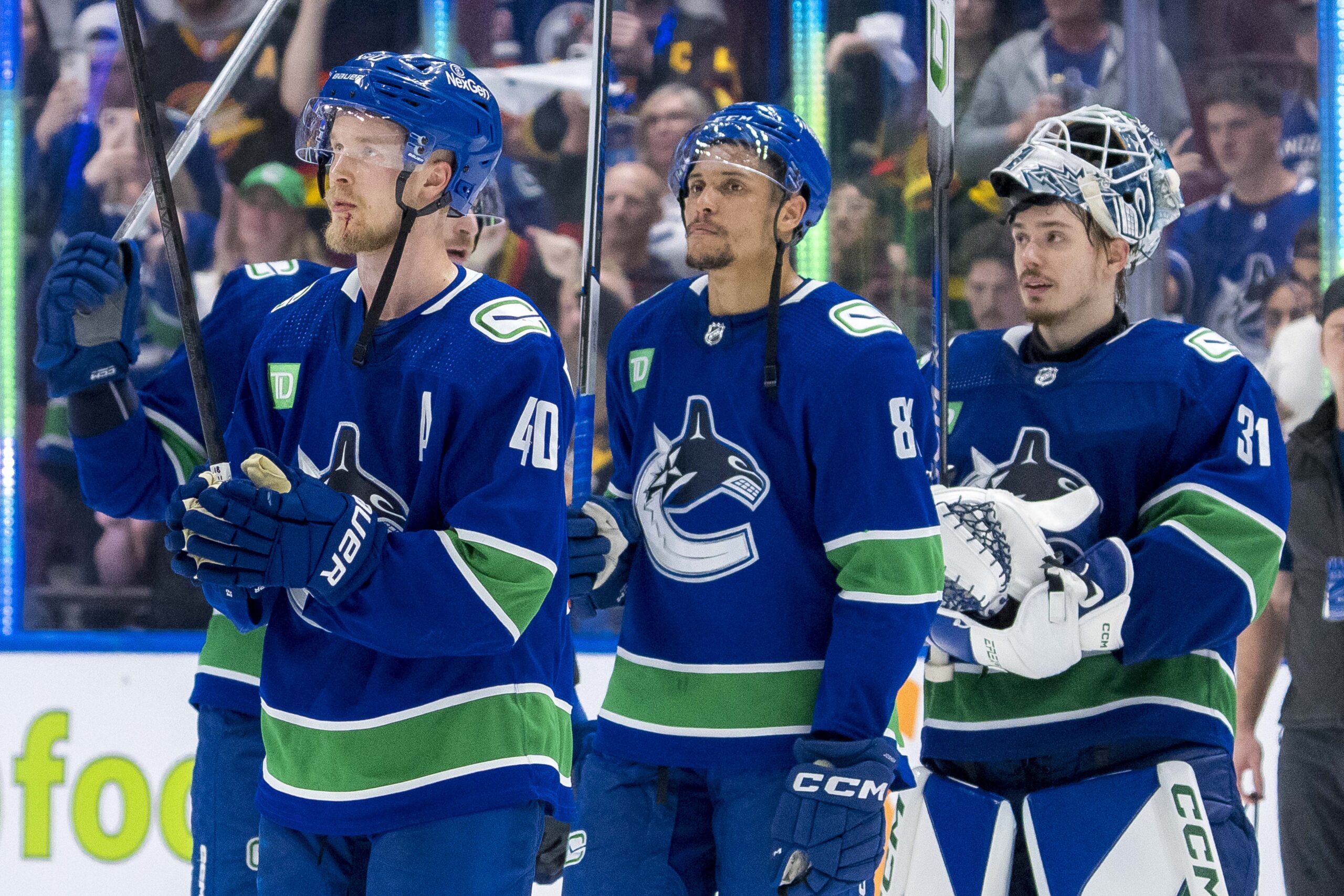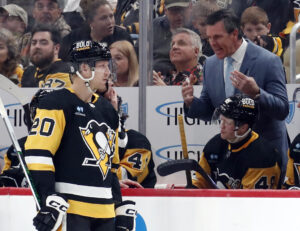The Vancouver Canucks forward lines lost an important player in Elias Lindholm; their big addition was Jake DeBrusk. Is it a one-for-one swap or not?
What Strategies Might Work for Canucks Forward Lines
Every team wants to score goals. One of the two main approaches to winning a season is “Score more than your opponents, you’ll probably win.” The other is “Allow fewer goals than your opponents, ditto.” That’s of less interest to fans, but coaches love it.
Joking platitudes aside, teams that have the talent to score lean into it. Teams that don’t try limiting opportunities for their opponents. The Canucks have been at both ends of the spectrum in their history. When their best player was in goal, then lock-it-down hockey was the rule of the day.
Last year, they finished eighth overall in league scoring. They also finished fifth overall in goals against, but that’s not as much fun. Getting more scoring is. So the team turned their eyes to one thing: getting a winger for Elias Pettersson.
Who They Had
The Canucks most successful line – in one sense – through 2023-24 was their so-called third line. Dakota Joshua, Conor Garland, and Teddy Blueger played 360 minutes together in 43 games. Blueger missed plenty of time with injuries, the only reason that line was split.
But while they had a fantastic expected goals average together, the trio didn’t actually score all that much. Their 21 goals were equal to 3.5 goals per 60 minutes. A perfectly good rate, but well back of the five goals per 60 of Pius Suter, J.T. Miller, and Brock Boeser. The only line better was when Pettersson took Suter’s place.
Unfortunately, doing that shrunk “the Canucks forward lines” to “the Canucks forward line”. The Pettersson – Miller – Boeser was also pretty lucky, scoring far above expected. Their expected goals for was a ridiculously low 1.89 goals per 60 minutes – and they actually scored over 5.3. Those aren’t repeatable numbers, or at least ones they shouldn’t rely on.
Who They Have
DeBrusk found a home on a line with Charlie Coyle and Brad Marchand last season. That trio was by far the most consistent one the Bruins used last season. Despite the skill between them, they were actually below .500 through the year in expected goals. They finished with 2.28 expected goals for per 60 minutes, but 2.37 goals against.
In practice, of course, they were still a very skilled trio. By actual goals, they scored 14 times while allowing just nine. DeBrusk did better with Pavel Zacha and David Pastrňák, but the numbers were low. Just six goals for and four against doesn’t tell us a lot, other than he was better used elsewhere.
Zacha and Pastrňák did better with another new arrival, Danton Heinen, scoring 17 times while allowing six. Which makes things interesting in camp, we think.
Famous Canucks Forward Lines
“Famous” is a bit of a loaded term, but they were certainly local legends. There is no guarantee what worked in the past will work again, especially in sports. Different league, different coaching, and just the straightforward march of time makes comparisons difficult. That doesn’t mean looking to the past is useless, though. A whole lot happened there, after all.
Sedin & Sedin & Not
Henrik and Daniel Sedin are in the Hall of Fame, so it’s easy to think that anyone could play with them. “A pylon would get 40 points on their line!” That’s not true. We know that because the Canucks tried.
Veteran Trent Klatt worked their wing when they broke into the league and stayed with them early. Taylor Pyatt was there when they were expected to lead the team, which is doing things the hard way. Steve Bernier was there long enough to see plenty of chances die on his stick.
Even skilled players could have difficulty meshing with the duo. Loui Eriksson was signed expressly because of his play with them on Team Sweden, but it was an utter failure in Vancouver. Markus Naslund put too much skill in one spot, though he could play at their level.
So who was the best? If you ask, you can get a few answers. Alexandre Burrows. Jannik Hansen. Anson Carter – age of the respondent pending. The players who understood to let them use him how they wanted. Go fetch them the puck from the corner. Go to the net when they say. And get your stick on the ice.
West Coast Express
If fantasy stories have the classic Five-Man Band, hockey has a trio stereotype of its own. While not exactly the NES Fat-Skinny-Medium set, the threesome of Todd Bertuzzi, Brendan Morrison, and Markus Naslund kinda was, too. None of them started here but were brought to the team in some excellent trades.
Bertuzzi was a monster on the ice, and a go-to for anyone who wanted to point out that bulking up didn’t often work in hockey. Markus Näslund was the highest-skilled player for the Canucks since Pavel Bure with back-to-back-to-back 40-goal seasons. And Morrison was the smart-playing defensive conscience.
Those elements came together seamlessly, making a feared and astoundingly effective line. They averaged 240 points per season between the three of them, with Naslund picking up the Ted Lindsay Award in 2003. That mix dominated the league for two years before a terrible decision by Bertuzzi ended it. That moment and the owners’ lockout of 2004-05 ended what momentum they had and never regained.
Who They Have
The most famous of the Canucks forward lines – again, locally – is probably the unnamed Garland – Joshua – Blueger trio. Frankly, that’s a perfect setup for an all-new NES line if I’ve ever seen one, but they don’t like fun. Plus that shouldn’t be a line a team needs to rely on. They carried Vancouver through a .500 slump, but they aren’t the top line.
Leaving those three together – without a guarantee that last season’s chemistry will repeat – seems like a no-brainer. Don’t think it through too much, and see what can be done up top. The fourth line will be a mix of prospects and potential, likely Kiefer Sherwood and Vasily Podkolzin with… Well, let’s get into that.
That leaves a question of who DeBrusk skates with and what that decision leaves for the “other” line. The instant the trade was made, the expectation was that he’d help Pettersson by adding another finisher. However, his play style – plenty of grit with some net-front presence – could work better with Boeser and Miller. He has always been an inconsistent producer, which isn’t what Pettersson needs.
The line of Suter – Miller – Boeser was far and away Vancouver’s most dangerous in the playoffs. They were also very good for the third of the regular season they played together. Given the proven results, why not return that set, at least to start the season? One reason could be that they need a centre for their fourth line.
Best Winger or Worst Centre Conundrum
Vancouver added to their winger strength. It was a weakness, and now they’ve fortified it. Except that now there is a question on how to give those wingers the most talented centres. Dropping Suter down for Heinen is a possibility, but Heinen has never been trusted with top-six minutes before. He’s 29 years old now and isn’t likely to change his game all that much. How much can he add, and where?
Putting Suter in the bottom six seems a waste of his talent at this point, even if he’s needed there. Worse, taking him out of the top six seems a waste of other players’ talent, too. In theory, Joshua can play centre, but it’s far from his best position. The next centre on the depth chart is probably Nils Åman, but he’s a bit of a black hole offensively.
This is actually where Aatu Räty might get his chance. If the team decides the 21-year-old is ready for the NHL in a limited role, it could be the perfect place to slot him in. He has all the physical tools to collect points and, despite your memories, has plenty of development time ahead. The question is which league he spends it in.
SSN or Express?
The answer to which Canucks forward lines they should draw inspiration from next year is “both”.
Boeser and Miller work as a pair extremely well, and adding “not one of them” is really the only choice there. They definitely should not be broken up, and whoever joins them will need to follow their lead. DeBrusk can play the Burrows role to their Sedins, going where they point and throwing his body after the puck.
His linemates are very good at both passing and shooting, so that dimension can only help them even if he doesn’t put up their numbers.
For Pettersson, he’s definitely more Naslund than Morrison or Bertuzzi. Suter makes for an excellent defensively-aware linemate who can still handle the puck with skill. In an ideal world, Podkolzin grows into that physical Bertuzzi-esque wallbanger role. But until then, Heinen seems like someone ready for the job – if Joshua doesn’t seize it first.
*Hat tip throughout to the invaluable MoneyPuck!
Main Photo: Bob Frid-USA TODAY Sports






